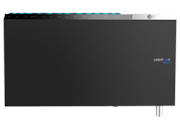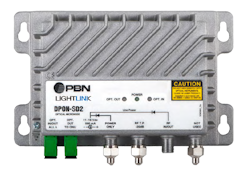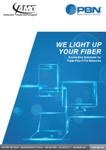![]()
Pacific Broadband Networks (PBN) – Fiber Optic Systems for FTTx, HFC and Ethernet networks
The PBN AOCM3600 GEPON OLT enhances the compact OLT 1RU series with a high-density L3 device. Designed with growing customer requirements in mind, this simple device serves up to 1024 GEPON subscribers while connecting to the uplink with 2x10GigE.
Full triple play services can be provided using IPTV Multicast or with PBN’s AIMA3000 platform with a full spectrum CATV overlay. PBN’s PM500-series ONUs allow cost-efficient connectivity for high-value SLA customers and standard residential subscribers.
The PBN Light Link® DPON-SD2 is the Optical Node Unit (ONU) for new “RFoG” (RF over Glass) Fiber-to-the-Home (FTTH) architecture, and is optimized to work over PON standards-compliant FTTH networks. The Society of Cable Telecommunications Engineers has issued their standard document SCTE-174-2010 to cover the subject and set implementation guidelines.

The PBN EDFA-R optical amplifier with redundant power supplies provides a highly stable output. The key features include a multimode pump laser, unique Automatic Power Control (APC), and an Automatic Temperature Control (ATC) circuit that ensures reliability. The high precision microprocessor unit (MPU) ensures intelligent and easy controls through the front panel and web interface.

The PBN PM620 is the successor of PBN’s successful PM520 product, featuring the latest industry chipset and added support for the ITU-based GEPON standard. With wire-speed switching, NAT speed upto 900 Mbps, this device helps distribute the FTTH experience within the consumers home. Wi-Fi speeds of up to 600Mbps with triple-antenna 802.11 AC standard as well as backward compatible 802.11 b/g/n connects all devices in a user’s home seamlessly. With public Wi-Fi network offerings by MSOs becoming more popular every day, the PM620 supports up to 4 SSIDs which allow the re-use of the high-speed infrastructure without impacting the
The PBN AOCM2400 series switching products provide high-performance and low-cost L2 access switches for FTTx and IPTV deployments with an extensive feature set. Remote web management of the switches makes it easy to set up the network topology and conduct related configurations. All PBN switches support wire-speed switching and packet filtration up to layer 4.
The PBN LT1550 Light Link Series 2 optical transmitter model LT1550 employs a high performance thermally stabilised, DFB, low-chirp, isolated laser to transmit CATV signals. Operating on a specific optical wavelength in the ITU-DWDM grid, the unit suits single mode optical fibre networks with or without dense wavelength division multiplexing (DWDM).
The PBN AIMA3000 platform is PBN’s newly developed high-density, low-power consumption headend platform that enables MSOs to build or upgrade their networks to meet today’s and future multi-services access requirements.
The AIMA3000 simplifies MSO operators’ transition to IP Networks by providing a complete range of intelligent, interoperable, RF and optical modules for HFC, RFoG, PON video overlay and other applications.
The design employs a 19″ rack of 4RU height, with 17 slots for high-density application modules and integrated front and rear fiber-access panel for easy fiber management. Slot 0 is used for a System Management Module (ASMM). In total, one 4RU AIMA3000 chassis allows for configurations of 32 forward-path laser transmitters or 64 return-path receivers.
PBN FTTx products and services offer scalable solutions for startup providers as well as tier-1 operators. Operators are challenged with ever growing bandwidth demand and increasing price pressures. PBN’s PON based Point-to-Multipoint architecture and dedicated Point-to-Point (P2P) optical networks allow operators to be prepared for the future. PBN even offers the ability to combine these two approaches, in a cost effective way, into one headend and software system. Utilizing passive network architectures, both solutions eliminate active components in the distribution network. The passive architecture not only increases operation efficiency, but also makes many powered hubs redundant saving significant infrastructure and operational cost.









